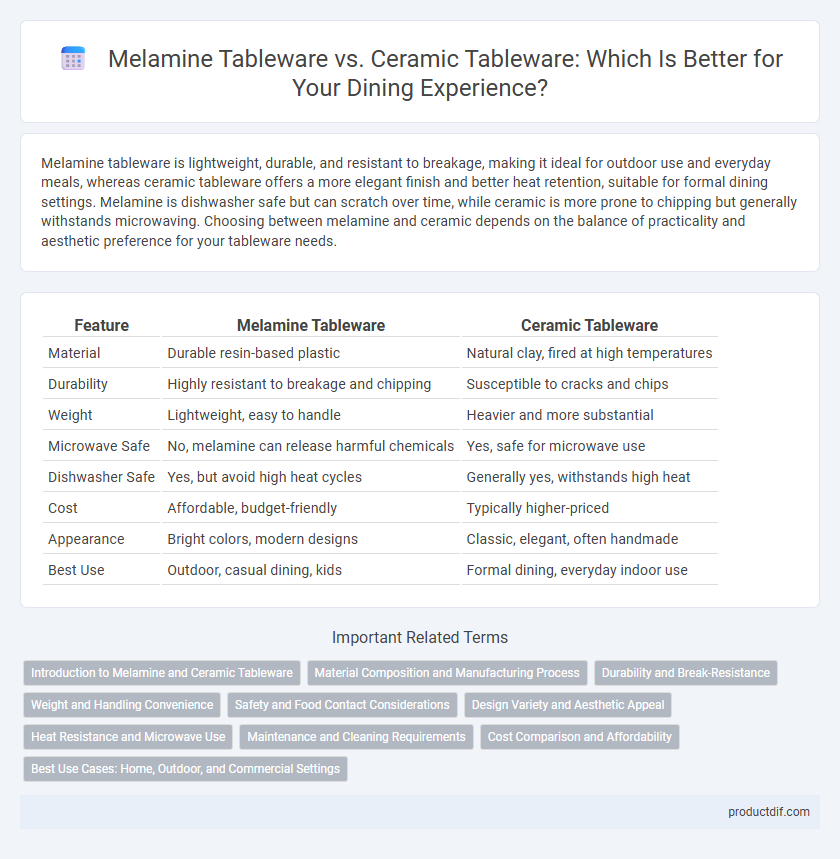Melamine tableware is lightweight, durable, and resistant to breakage, making it ideal for outdoor use and everyday meals, whereas ceramic tableware offers a more elegant finish and better heat retention, suitable for formal dining settings. Melamine is dishwasher safe but can scratch over time, while ceramic is more prone to chipping but generally withstands microwaving. Choosing between melamine and ceramic depends on the balance of practicality and aesthetic preference for your tableware needs.
Table of Comparison
| Feature | Melamine Tableware | Ceramic Tableware |
|---|---|---|
| Material | Durable resin-based plastic | Natural clay, fired at high temperatures |
| Durability | Highly resistant to breakage and chipping | Susceptible to cracks and chips |
| Weight | Lightweight, easy to handle | Heavier and more substantial |
| Microwave Safe | No, melamine can release harmful chemicals | Yes, safe for microwave use |
| Dishwasher Safe | Yes, but avoid high heat cycles | Generally yes, withstands high heat |
| Cost | Affordable, budget-friendly | Typically higher-priced |
| Appearance | Bright colors, modern designs | Classic, elegant, often handmade |
| Best Use | Outdoor, casual dining, kids | Formal dining, everyday indoor use |
Introduction to Melamine and Ceramic Tableware
Melamine tableware, made from durable resin, offers lightweight and shatter-resistant qualities ideal for outdoor use or casual dining. Ceramic tableware, crafted from natural clay and fired at high temperatures, provides an elegant, heat-resistant option preferred for formal settings and everyday use. Both materials vary significantly in durability, appearance, and maintenance, influencing their suitability across different dining environments.
Material Composition and Manufacturing Process
Melamine tableware is composed of melamine resin, a durable thermosetting plastic created by molding melamine-formaldehyde resin under high heat and pressure, resulting in lightweight, impact-resistant dishes. Ceramic tableware, made from natural clay mixed with minerals like kaolin and feldspar, undergoes a firing process at temperatures ranging from 1,200 to 1,400 degrees Celsius, producing a dense, fragile, and heat-retentive material. The synthetic polymer base of melamine offers superior breakage resistance and flexibility in design compared to the brittle, handcrafted nature of ceramic ware.
Durability and Break-Resistance
Melamine tableware offers superior durability and break-resistance compared to ceramic tableware, making it ideal for high-traffic environments such as restaurants and outdoor use. While ceramic tableware is prone to chipping and cracking upon impact, melamine resists shattering and maintains structural integrity under heavy use. This difference in material composition provides melamine with enhanced toughness, significantly reducing replacement costs in demanding settings.
Weight and Handling Convenience
Melamine tableware is significantly lighter than ceramic tableware, making it easier to handle and ideal for outdoor dining or casual use. Ceramic tableware, while heavier and more fragile, provides a sturdier feel and often greater heat resistance. The lightweight nature of melamine enhances portability and reduces breakage risk, whereas ceramic offers a classic, durable option better suited for formal settings.
Safety and Food Contact Considerations
Melamine tableware is BPA-free and durable but should not be used in microwaves or with hot acidic foods due to potential chemical leaching. Ceramic tableware is generally safe for all types of food contact, including hot dishes and microwaving, provided it is lead-free and glazed properly. Both materials require checking manufacturer certifications to ensure compliance with food safety standards for daily use.
Design Variety and Aesthetic Appeal
Melamine tableware offers a broad range of vibrant colors and playful patterns, making it ideal for casual dining and outdoor settings. Ceramic tableware excels in elegant finishes and intricate designs, providing a timeless aesthetic suited for formal occasions. The durability of melamine combined with the refined artistry of ceramic caters to diverse design preferences in tableware collections.
Heat Resistance and Microwave Use
Melamine tableware offers excellent heat resistance up to 160degC, making it durable for everyday use but unsuitable for microwave ovens due to its potential to melt or leach chemicals. Ceramic tableware withstands higher temperatures, often exceeding 1000degC, and is microwave-safe, allowing for convenient reheating without health risks. Choosing ceramic ensures better performance in microwave use, while melamine suits casual, non-microwave heating scenarios.
Maintenance and Cleaning Requirements
Melamine tableware is highly durable and stain-resistant, requiring only gentle hand washing to maintain its appearance, while it is not dishwasher safe and should be kept away from high heat to prevent warping. Ceramic tableware is more prone to chipping and requires careful handling but can often be safely cleaned in a dishwasher and is microwave-friendly. Both materials benefit from using non-abrasive cleaners to preserve their finish and extend their lifespan.
Cost Comparison and Affordability
Melamine tableware is generally more affordable than ceramic tableware due to lower manufacturing costs and durability that reduces replacement frequency. Ceramic tableware often carries a higher price point because of its material, craftsmanship, and longer production process. Choosing melamine offers budget-friendly options for everyday use, while ceramic provides a premium aesthetic worth the investment for formal dining.
Best Use Cases: Home, Outdoor, and Commercial Settings
Melamine tableware excels in outdoor and commercial settings due to its lightweight, shatterproof, and durable properties, making it ideal for high-traffic or casual dining environments. Ceramic tableware, known for its elegant appearance and heat retention, is best suited for home use and formal dining where aesthetics and food presentation are prioritized. Both materials offer distinct advantages: melamine for practicality in active spaces, and ceramic for refined dining experiences.
Melamine Tableware vs Ceramic Tableware Infographic

 productdif.com
productdif.com